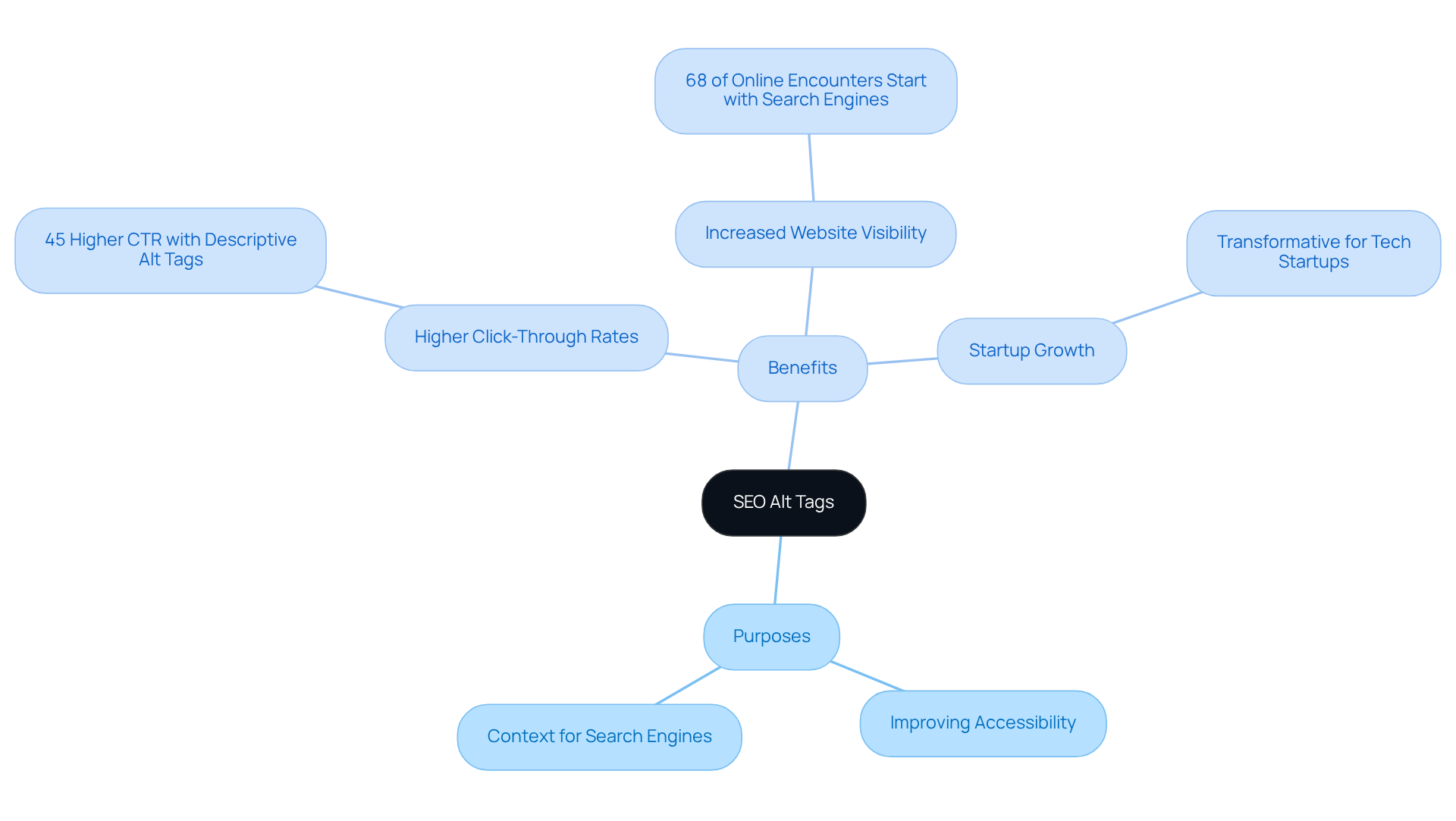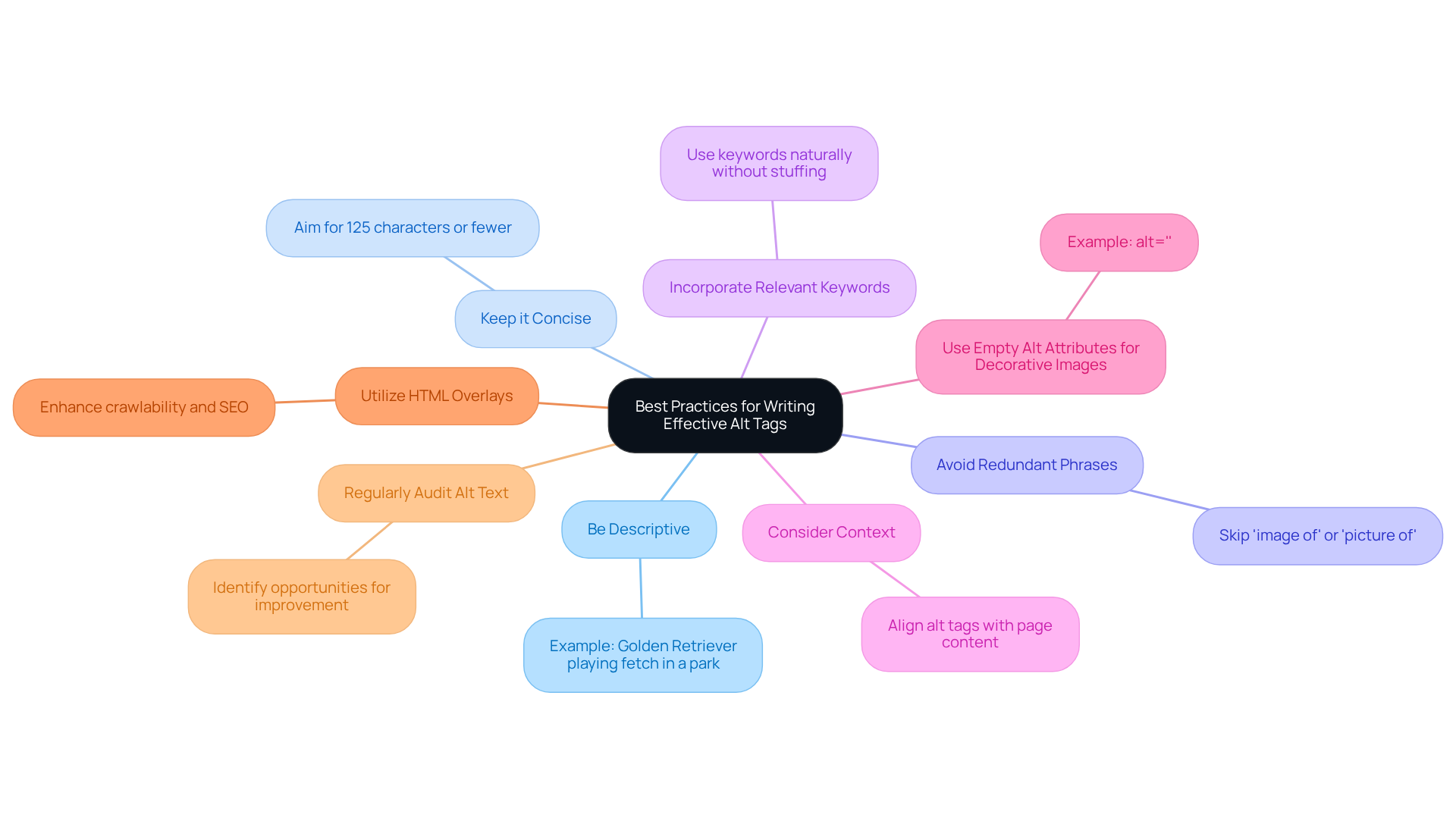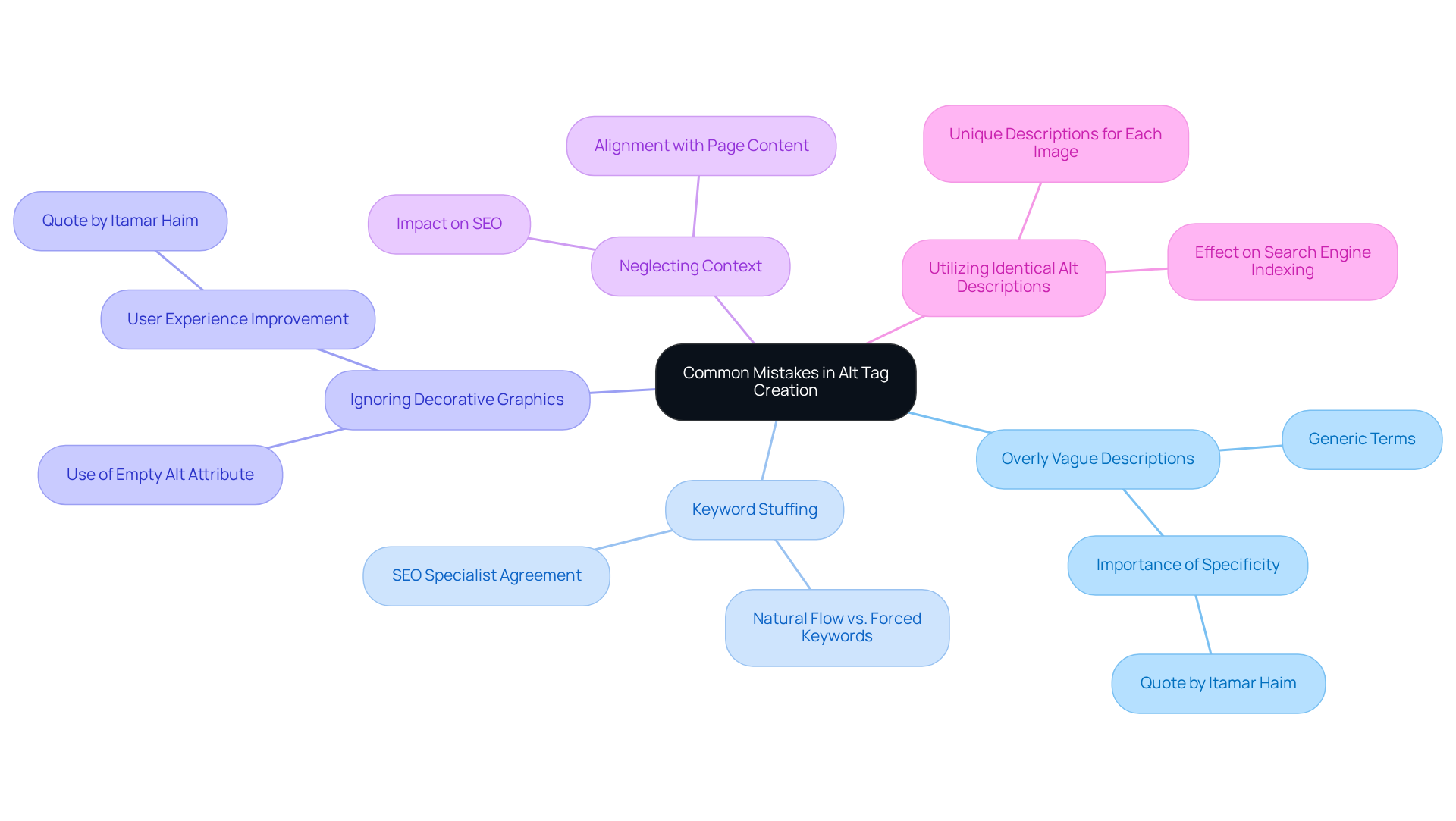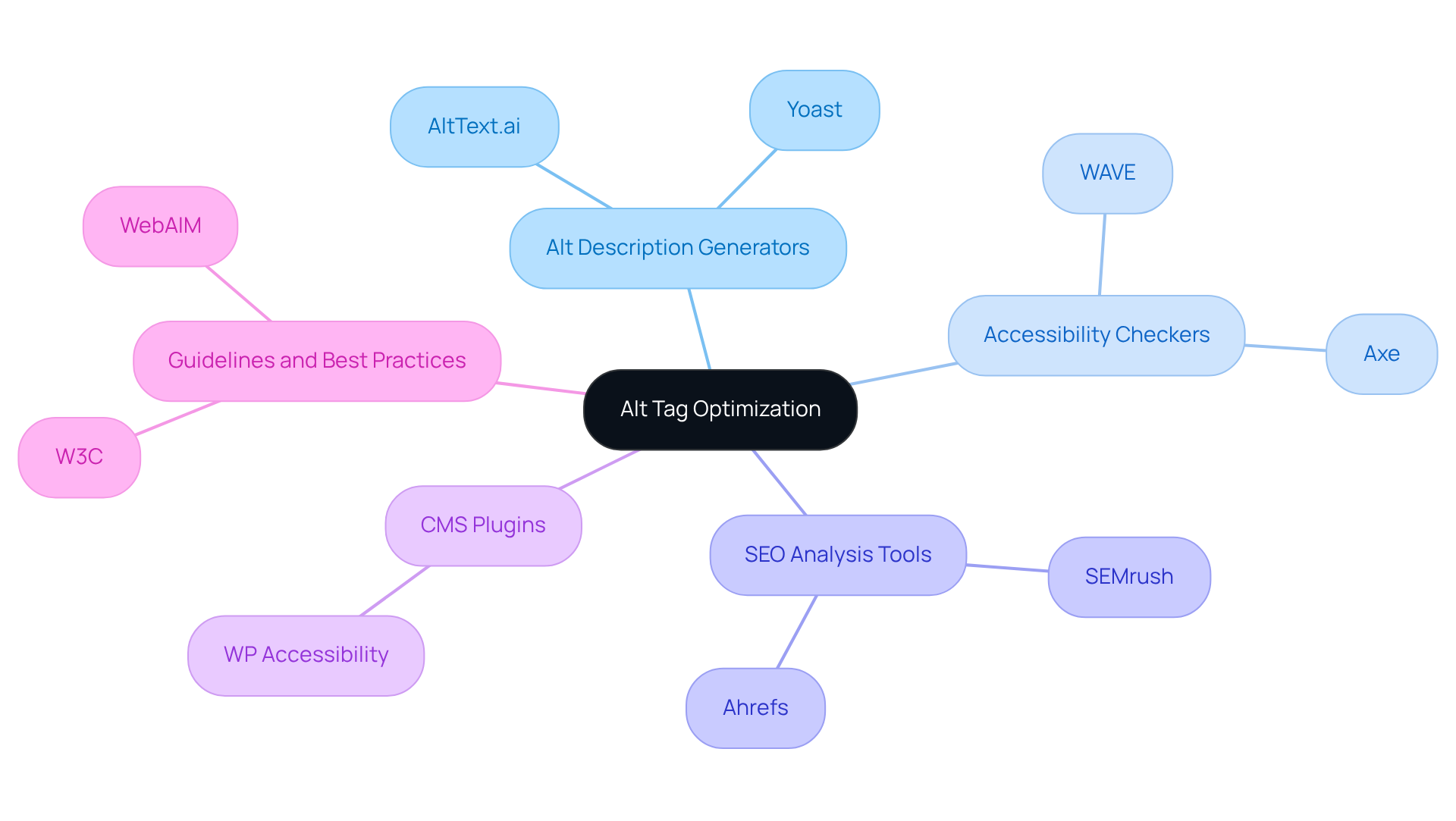Overview
The article addresses a crucial challenge faced by tech startups: optimizing SEO alt tags. These tags are vital for enhancing website visibility and accessibility, yet many founders struggle with them. This struggle can lead to missed opportunities for reaching the right audience and providing an inclusive experience for all users. It’s important to recognize how this oversight can affect not just search engine performance but also the overall user experience.
To help navigate this complex landscape, the article offers compassionate guidance on best practices for crafting effective alt tags. It encourages being descriptive yet concise, steering clear of keyword stuffing, and utilizing helpful tools for alt tag creation. By embracing these strategies, tech startups can significantly improve their search engine performance and foster a more welcoming online environment.
As you embark on this journey, remember that you are not alone. Many founders share these challenges, and by implementing these nurturing practices, you can enhance your website's accessibility and visibility, ultimately paving the way for greater success.
Introduction
Understanding the nuances of SEO alt tags can feel overwhelming, especially for tech startups eager to enhance their online presence. These often-overlooked elements are not just technical details; they significantly improve accessibility for visually impaired users and play a crucial role in how search engines interpret and rank images.
In a digital landscape that grows more competitive by the day, the challenge for many founders is mastering the art of crafting effective alt tags. This skill is vital for boosting visibility and driving organic traffic.
How can startups like yours leverage these strategies to stand out and truly connect with your audience? Let's explore this together, ensuring you feel supported every step of the way.
Understand Alt Tags and Their Importance for SEO
, also known as alternative descriptions, are a crucial aspect of your website’s visuals. They serve two essential purposes: for visually impaired individuals and providing context to search engines about your images. The challenge is that search engines cannot interpret images visually; they depend on the seo alt tag to understand what each image represents. This understanding is vital for SEO.
If your alternative descriptions, specifically your seo alt tag, are well-optimized, they can significantly in search engine results. For , is not merely advantageous; it can be transformative in attracting organic traffic and improving user experience.
Research shows that pages with descriptive seo alt tags can achieve a , underscoring the direct influence of alt tags on website performance. Furthermore, with , ensuring your visuals are appropriately labeled can truly be a game-changer in your digital marketing strategy.
By taking the time to optimize the seo alt tag, you are not just improving accessibility; you are also opening doors for your startup’s growth and connection with users. Let’s embrace this opportunity together.

Follow Best Practices for Writing Effective Alt Tags
can feel overwhelming, especially when you want to ensure that your visuals are accessible to everyone. It's crucial to understand that serve a dual purpose: and . So, how can we make this process easier for you?
- Be descriptive and specific. Instead of simply saying 'dog', try 'Golden Retriever playing fetch in a park'. This detail not only helps users understand the image better but also supports your SEO efforts by utilizing an SEO alt tag.
- Keep it concise. Aim for descriptions of 125 characters or fewer. This approach ensures that screen readers can quickly convey the information, enhancing accessibility without overwhelming users.
- Avoid redundant phrases. Starting with 'image of' or 'picture of' is unnecessary since this is already understood. Focus directly on the content to maximize clarity.
- Incorporate relevant keywords naturally into your descriptions. This can bolster the effectiveness of your SEO alt tag. However, be cautious of keyword stuffing, as this can lead to penalties from search engines and detract from the user experience.
- Consider how your visual elements connect to the accompanying text and the overall content of the page. that align with the page's context not only boosts SEO but also enhances the user experience, making it more intuitive and engaging.
- Accessibility is a significant concern; around 21.6% of visuals on assessed home pages lack alternative descriptions. This highlights the importance of . As Rachel Handley wisely notes, "Alternative descriptions are important because they enhance the accessibility of your visuals: they assist users who are unable to view visuals in comprehending their content."
- For purely decorative graphics, use empty alt attributes (alt='') to help screen readers skip them, ensuring a smoother experience for users relying on assistive technologies.
- Consider utilizing HTML overlays. This technique can enhance crawlability and optimize visuals for SEO, improving both user experience and search engine performance. By following these best practices, you can create a more inclusive digital environment for everyone.

Avoid Common Mistakes in Alt Tag Creation
When creating alt tags, it's essential to be mindful of some that can hinder your efforts:
- Overly Vague Descriptions: Using generic terms like 'image' or 'photo' fails to provide meaningful context. Instead, be specific about what the image depicts. As Itamar Haim wisely points out, 'Your alt description should enhance the content surrounding it,' ensuring clarity and relevance for your audience.
- Keyword Stuffing: While incorporating keywords is important, overloading alt descriptions with them can negatively impact your SEO and readability. Strive for a natural flow that prioritizes accurate descriptions over forced keywords. It’s noteworthy that 50% of SEO specialists agree that a is crucial for ranking in Google Images.
- Ignoring Decorative Graphics: For purely decorative images that do not add value to the content, use an empty alt attribute (alt="") to indicate that they can be overlooked by screen readers. This small adjustment can greatly enhance the user experience, especially when images fail to load. As Itamar Haim mentions, "If an image doesn’t load for any reason... the alternative description will display instead."
- Neglecting Context: It’s vital that your alternative descriptions align with the page's content. Misleading descriptions can confuse users and negatively affect SEO. Ensuring that alternative descriptions are in harmony with surrounding content is key to maintaining clarity.
- Utilizing Identical Alt Descriptions for Various Pictures: Each image should have a that accurately conveys its content. Repeating descriptions can dilute their effectiveness and hinder search engine indexing.
By steering clear of these common mistakes, can significantly boost their through while fostering a more inclusive experience for all users. Websites that effectively utilize optimized images can experience up to 40% more organic traffic, highlighting the positive impact of well-crafted alternative descriptions.

Utilize Tools and Resources for Alt Tag Optimization
Optimizing your seo alt tag can feel daunting, especially when you’re already juggling so many responsibilities. It’s crucial to understand that neglecting the seo alt tag can impact your website’s and search engine performance, making it harder for users to find you. But don’t worry; there are available to help you navigate this process with ease.
Consider using like AltText.ai and Yoast. These tools , and saving you precious time without compromising quality. As Joost de Valk, the creator of Yoast, wisely points out, 'Well-crafted seo alt tags can greatly enhance a website's SEO and accessibility.'
Next, take advantage of Accessibility Checkers such as WAVE or Axe. These tools allow you to assess your website's accessibility, ensuring that your alt tags are not only effective but also compliant with established standards. This step is essential for for all users.
Moreover, like SEMrush and Ahrefs can provide valuable insights into your website's . They help you understand how your seo alt tag influences search rankings. By enhancing your visuals, you can significantly boost your site's SEO and attract visitors through Google visuals.
For those using WordPress, Content Management System (CMS) Plugins like WP Accessibility can assist in managing alternative descriptions across your site. This makes it incredibly simple to improve overall accessibility—just log in, modify your post, select the image, and refresh the alternative description.
Finally, don’t forget to consult the Guidelines and Best Practices for using the seo alt tag from organizations like the W3C and WebAIM. They offer comprehensive resources on creating effective alternative descriptions that enhance both accessibility and SEO. You might also find inspiration in the case study on Clarifai, which showcases its capabilities in crafting optimized alt texts for search engines, demonstrating the real-world effectiveness of these tools.
By embracing these resources and tools, you’re not just optimizing your website; you’re fostering a more inclusive online environment. Remember, every step you take toward improving accessibility is a step toward supporting all users in their journey to connect with your content.

Conclusion
Mastering the art of SEO alt tags is a vital journey for tech startups striving to enhance their online presence and connect with a wider audience. The challenge lies in effectively utilizing alt tags, which not only improves accessibility for users but also elevates search engine visibility. This dual advantage nurtures inclusivity and positions startups for greater success in an increasingly competitive digital landscape.
Many founders may feel overwhelmed by the complexities of SEO, often worrying that their efforts might not yield the desired results. It's essential to recognize that vague descriptions and keyword stuffing can hinder the effectiveness of alt tags, leaving them feeling frustrated and unseen. However, there is hope. By crafting descriptive, concise, and contextually relevant alt tags, startups can truly make a difference. Utilizing tools and resources can streamline this optimization process, making it more manageable and effective.
Ultimately, committing to the optimization of alt tags is a proactive step toward fostering a more inclusive online environment. Every effort made in this direction not only enhances user experience but also drives organic traffic and engagement. Embracing these strategies will empower tech startups to thrive in the ever-evolving world of digital marketing, ensuring that they remain visible and accessible to all users. Together, we can create a digital space where every voice is heard and valued.
Frequently Asked Questions
What are SEO alt tags?
SEO alt tags, also known as alternative descriptions, are text descriptions that provide context about images on a website. They serve to improve accessibility for visually impaired individuals and help search engines understand what each image represents.
Why are alt tags important for SEO?
Alt tags are important for SEO because they help search engines interpret images, which is vital for improving a website's visibility in search engine results. Well-optimized alt tags can significantly enhance organic traffic and improve user experience.
How do well-optimized alt tags affect website performance?
Research indicates that pages with descriptive SEO alt tags can achieve a 45% higher click-through rate, highlighting their direct influence on website performance and engagement.
What is the impact of search engines on online encounters?
Approximately 68% of online encounters begin with a search engine, making it crucial for websites to ensure their visuals are properly labeled with alt tags to enhance discoverability.
How can optimizing alt tags benefit tech startups?
For tech startups facing intense competition, optimizing SEO alt tags can be transformative in attracting organic traffic and fostering better connections with users, ultimately contributing to the startup's growth.




